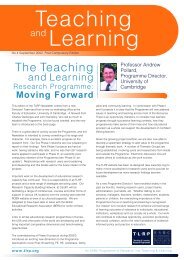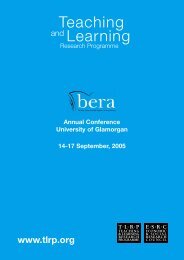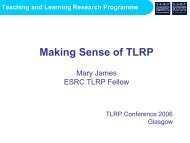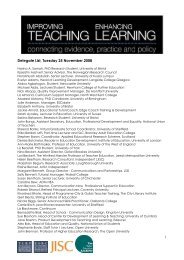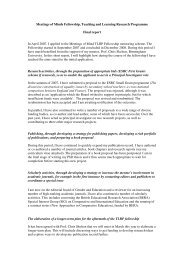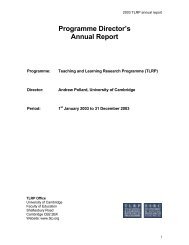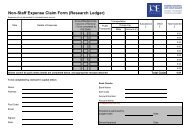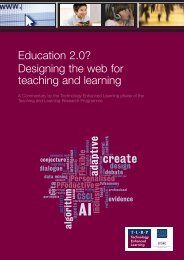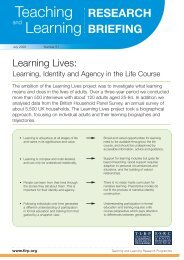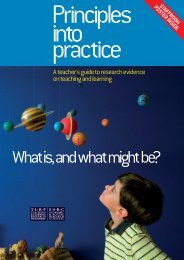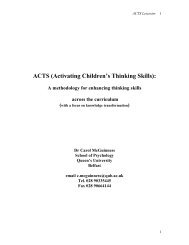Bera Booklet 2007 - Teaching and Learning Research Programme
Bera Booklet 2007 - Teaching and Learning Research Programme
Bera Booklet 2007 - Teaching and Learning Research Programme
Create successful ePaper yourself
Turn your PDF publications into a flip-book with our unique Google optimized e-Paper software.
Conference booklet 21/8/07 10:16 am Page 40early to mid adulthood, mid adulthood to late adulthood, <strong>and</strong> late adulthood to old age,respectively. The collapsing of adjacent age groups into one cohort is designed to give usviable sample sizes with which to work.Our purpose in this paper is demonstrate how we have gone about exploring the ways inwhich a selection of life course transitions <strong>and</strong> events cohere in significant ways with oneanother <strong>and</strong> with participation in learning, in particular. We will showcase how we haveused a latent structure approach to identify distinctive paths of role configurations withineach of our 3 cohorts that effectively characterize that particular cohort at a given age <strong>and</strong>to draw up conditional probabilities for latent role configurations.We will then show how we have used the patterns that have emerged empirically formthese analyses to• assess the chances of a given individual being in adult learning at a given age/stage oftheir lives <strong>and</strong> how this is influenced by the shape of their other social role trajectoriesover time• assess the extent to which people’s learning trajectories vary across individuals, socialgroups, age groups, time <strong>and</strong> contexts <strong>and</strong> the degree to which variations found areconsequential for learning, identity transformation <strong>and</strong> agency.• explore whether a given individual has a propensity to adhere to a specific type of lifepath <strong>and</strong> whether normative paths exist.• map a selection of our case study participants on to the wider patterns of life paths thathave emerged <strong>and</strong> examine the extent to which they have followed a normative ordeviant pathPaper 2In/formality in Lifelong <strong>Learning</strong> CareersAuthors: Phil Hodkinson, Heather Hodkinson,University of Leeds, Geoff Ford, RuthHawthorn, NICECAbstract: Early learning careers literature (Bloomer, 1997; Bloomer <strong>and</strong> Hodkinson, 2000)concentrated on people’s experiences of education. However, implicit in the analysespresented was an awareness of the significance of everyday lives on those learning careers,through what is often termed ‘informal’ learning. Furthermore, that early learning careersliterature focused on relatively short periods in people’s lives. This paper presents a furtherdevelopment of the learning careers ideas, by showing how such careers develop overmuch longer periods of time, <strong>and</strong> how informal learning is at least as important withinlearning careers as is formal learning. As Colley et al. (2003) suggest, the distinctionbetween formal <strong>and</strong> informal learning is unclear <strong>and</strong> unhelpful in examining the significanceof learning in people’s lives.The paper draws upon qualitative data from the <strong>Learning</strong> Lives research project, combininglife history methods with real time longitudinal qualitative research, between 2003 <strong>and</strong><strong>2007</strong>. We present a small number of individual stories, showing some of the different waysMajor Schools Mailout – Don’t Miss it!Teachers’ Guide <strong>and</strong> DVD on School FindingsTLRP is undertaking a major initiative to disseminate the findings of schoolsprojects. The ‘Video-assets’ project, based at Bristol has produced an excellentDVD illustrating some of TLRP’s ten ‘principles of teaching <strong>and</strong> learning’. ATeachers’ Guide has also been produced, which presents findings <strong>and</strong> principlesin a more expansive way. These materials will be sent as a package to all UKschools in September. You can view these materials at the TLRP st<strong>and</strong> at BERA.in which learning careers develop. For some people, a learning career includes virtuallyno formal education, after they have left school. However, even these people have oftenexperienced some form of formalized work-based training. For others, an on-goingengagement with some form of adult education has been important for one or more lengthyperiods in their lives. However, in all such cases, learning outside the courses is at least asimportant as learning within them, <strong>and</strong> the formal <strong>and</strong> informal attributes of their learningare often closely interrelated.In all learning careers, the balance <strong>and</strong> interrelationships between continuity <strong>and</strong> changeare important, <strong>and</strong> can alter from person to person <strong>and</strong> from time to time. A person’sdispositions both influence their learning, <strong>and</strong> are influenced by it. Both the learning <strong>and</strong> theperson’s dispositions are also influenced by their position in the world, which can <strong>and</strong> doesalso change, over time. It is important to underst<strong>and</strong> position at a variety of scales ofattention. It includes what are often termed structural concerns such as class, ethnicity<strong>and</strong> gender; geographical location; <strong>and</strong> the contexts of people’s lives, such as work, family<strong>and</strong> local community. Also, as Bloomer <strong>and</strong> Hodkinson (2000) argued, dispositions areembodied, not just cognitive. This means that changes to the body, for example throughaging, illness or accident, can change both a person’s dispositions <strong>and</strong> their position inrelation to their lives.These changing interrelationships of formal <strong>and</strong> informal attributes of learning, <strong>and</strong> betweenlearning, dispositions <strong>and</strong> position, demonstrate that learning can be helpfully understoodas a lifelong process of becoming.Paper 3Resourcing Lifelong <strong>Learning</strong>: Exploring the Opportunities for Biographical<strong>Learning</strong> in the LifecourseAuthors: Gert Biesta <strong>and</strong> Michael Tedder, School of Education <strong>and</strong> Lifelong<strong>Learning</strong>, University of ExeterAbstract: One of the more intriguing findings from the interviews we conducted with adultsfrom a wide range of different backgrounds <strong>and</strong> ages <strong>and</strong> stages of life is that they haverelatively little to say about the meaning <strong>and</strong> impact of formal education when asked totalk about their life. We found that many people will talk willingly about one or more schoolsubjects they were good at or not good at, about the teachers <strong>and</strong> tutors they liked <strong>and</strong>disliked, <strong>and</strong> about their friends <strong>and</strong> peers. Yet they say little about what knowledge <strong>and</strong>skills they acquired, or whether their ideas, attitudes or beliefs have changed. Similarly,many participants find it difficult to articulate what they have learned from their life.Even when prompted, responses tend to be clichés referring to the ‘university of life’ or‘experience being the best teacher.’ Nonetheless, the life-stories told by our participantsprovide abundant evidence that people have learned from their lives <strong>and</strong> do learn fromtheir lives <strong>and</strong> that their learning has had an impact on the ways in which they cope withimportant life-events.This raises an important question. If lifelong learning is more than the acquisition ofqualifications through participation in formal education; if, in other words, an importantaspect of lifelong learning has to do with the ways in which people learn from their lives<strong>and</strong>, through this, learn for their lives, then we must ask what opportunities people haveto engage in such processes of ‘biographical learning’ (for this concept see Alheit 1995;Alheit & Dausien 2002) <strong>and</strong> how such opportunities <strong>and</strong> the access to them are structureddifferently for different individuals at different ages <strong>and</strong> stages in their lives. We mustask also what kind of discursive <strong>and</strong> social resources might help people to learn moreeffectively <strong>and</strong> pro-actively from their lives <strong>and</strong> in what kinds of institutions <strong>and</strong> communitiescan we find such resources (see rugger 1995). In this presentation we explore thesequestions through a discussion of aspects of the life stories of several participants in ourproject. We focus our discussion on key transitions in the lives of our participants, becauseit is often around such events that learning from one’s life becomes a necessity in orderto learn for one’s future life. Transitions are also the moments in people’s lives whenbiographical learning is most visible.4041



